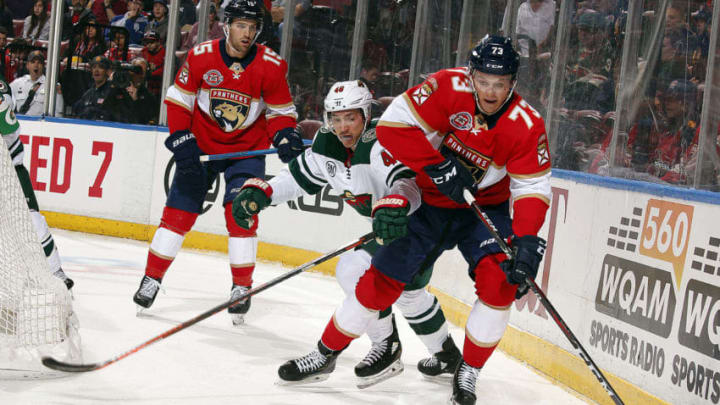Florida Panthers: Improving Bottom Six Should be a Crucial Part of the Offseason

Most of the rumors about the Florida Panthers’ offseason plans center on them going after big fish such as Sergei Bobrovsky and Artemi Panarin.
With money to spend, and eyes on making an even bigger splash after hiring Joel Quenneville, this makes sense.
But success might not be dictated by big game hunting this June and July, it could well be on how the Florida Panthers fix an issue they haven’t been able to fix for the best part of the entire decade: their bottom six.
While the coaching change and upgrading the goaltending position will fix quite a lot of what has ailed the Panthers in their last three failed seasons, one area that has been a persistent problem is scoring depth.
The Panthers have gotten next to nothing out of their bottom six, no matter the personnel changes, line combinations, and deployment decisions tried by multiple coaching groups.
If there’s anything that the runs the Bruins and Blues have gone on this postseason, depth of scoring and trust is as important as a dominant top six or a hot goaltender.
Take this from Harman Dayal of the Athletic: 5v5 goal differential per 60 minutes for teams when their top two centers weren’t on the ice
Florida is fourth worst in the NHL in this metric, only in front of perennial basement dwellers Ottawa, New Jersey, and Vancouver.
Every team that is a net positive in this area made the postseason, and the lowest to do was Colorado. While other issues for the Panthers have gotten more internet ink, the bottom-six problems are perhaps even more noticeable considering what has won out this postseason.
Some of those issues can be linked to the goaltending of course, but Bob Boughner and his coaching staff never trusted any of the bottom-six combinations they put out, and they used far too many.
Only Jayce Hawryluk, Denis Malgin, and Frank Vatrano had positive CF% Rel of the often used bottom-six forwards according to Hockey Reference, and if you use Evolving Hockey’s wonderful RAPM (Regularized Adjusted Plus-Minus), which allows you to see offensive and defensive impacts on CF (Corsi For), xG (Expected Goals) and GF (Goals For), there are a lot of red bars for Panthers forwards compared to those bottom-six forwards on playoff teams, and most of it comes in offensive categories.
Florida’s bottom six was one of the worst groups in the NHL last year for a multitude of reasons, which led to another season of the Panthers’ offense being far too top heavy despite having five 20+ goal scorers and four 70+ point getters.
If you include Frank Vatrano in the top six as he was for most of last year, the highest point producer of the bottom six was Troy Brouwer at 21 points in 75 games. To get to the playoffs, let alone win a series in the postseason, that cannot happen again.
How can the recurring problem be fixed? Part of it has to do with system and trust and putting these players in a position to succeed.
This means as much as possible giving players like Borgstrom, Malgin, and Hawryluk consistent linemates, consistent deployment, and an element of trust too.
These players were clearly not trusted in critical situations last year, hence the ice time imbalance with likes of Barkov, Huberdeau, and the rest.
Joel Quenneville is a different coach with a different system and a different idea of how he wants his bottom six used, but that can only go so far.
Some of that comes in personnel, too. The bottom six cannot be full of players like Dryden Hunt, Micheal Haley, and Riley Sheahan again, because the evidence suggests that the Panthers aren’t competitive with them filling out the bottom six.
Whether that means elevating the roles of players mentioned above, bringing in more young players like Aleksi Heponiemi to the NHL lineup or finding free agents that can be a net positive offensively and in puck possession while also doing the little things that a coach like Joel Quenneville will expect out of his bottom six is crucial.
dark. Next. Lammikko and Finland Take Gold at 2019 IIHF Worlds
Most of the offseason headlines will belong to the Panthers’ efforts to bring in the biggest free agents and make the biggest deals. But it could be what they do in their bottom six that truly determines how far they can go.